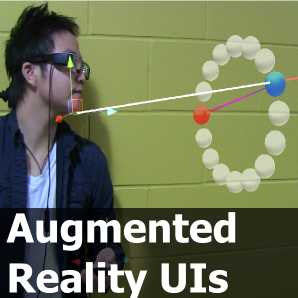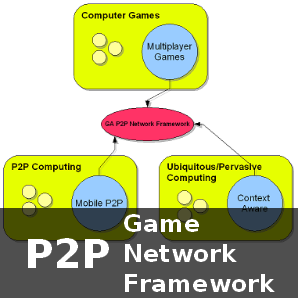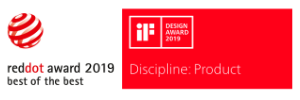| Current Projects | |
| Google Maps LiveView
I currently work for Google Maps as part of the team creating LiveView. LiveView is basically an exploration into what the Map looks like from a first-person view in AR. Of course, I am limited to talk only about the things that are public and the two videos below are a great summary. I would like to add that LiveView is the first instance of a world-scale AR cloud, one of the core enabling technologies for augmented and mixed reality a fundamental building block of the future. Awards
|
| Previous Projects | |
| AR Virtual Monitors for PC
This was my favorite project at Lenovo: creating a very lightweight AR headset with a very specific use case – virtual monitors for laptops. I pitched this idea while in Lenovo Research and worked with a very talented team to create the first hardware and software prototypes. I don’t know whether they will be launching it or not, but I am glad they made the prototype public so now I can talk about it. We also filed some interesting patents for it (see below).
Awards
|
|
| ThinkReality A6 – An Augmented Reality Headset for Industrial Users
During my last year at Lenovo, I worked in the product design for the ThinkReality A6 headset. This is Lenovo’s first commercial AR headset (meaning aimed at Lenovo’s industrial partners) and has the complete set of AR sensors and functionalities.
|
|
 |
Interaction Techniques for Augmented Reality in Head-Mounted Displays A new generation of head-mounted displays such as Microsoft HoloLens, EPSON Moverio, and ODG devices are able to generate 3D content which seems to exist in the real world around us. A major challenge is how to interact with such digital content, including input devices and interaction techniques as well as the corresponding UI paradigms and elements to support such input.
|
| Color Correction on Transparent (Optical See-Through) Displays Transparent displays, whether used for spatial augmented reality or for head-mounted displays, are subject to color blending — users perceive color as a combination of the display color and the background. In this project we investigate the theoretical foundations of color blending, and propose practical solutions to this problem by means of color correction algorithms. Our results not only outperform existing solutions, but also do so without requiring extra hardware and in real-time.
|
|
| Consumed Endurance (CE) – Arm Fatigue in Mid-Air Interactions Consumed Endurance (CE) is a metric that captures the degree of arm fatigue during mid-air interactions. Based on the bio-mechanical structure of the arm, CE can assist with the design of minimally fatiguing gestural interfaces. CE derives its validity from a strong to perfect correlation to the Borg CR10 scale for physical exertion.
|
|
| tPad – Transparent-Display Mobile Devices Transparent display mobile devices have long been the focus of science fiction and design concepts for future technologies. However, research is scarce about the actual benefits they can bring to mobile interactions. This project explores how transparent display mobile devices can help everyday mobile tasks such as task switching and photo capture. We present two different prototypes and discuss technical challenges.
Media Coverage
|
|
 |
CrashAlert In this project we look at how depth cameras can assist mobile phone users when they are texting and walking. The prototype, called CrashAlert, detects obstacles on the walking path of the user and presents notifications in the form of ambient visualizations on the top of the device.
Media Coverage
|
| eLabBench The eLabBench is a interactive tabletop designed to support the laboratory work of molecular biologists. Our design allows users to capture information while in the lab, to execute digital tasks, and to move information between the lab and their offices in a seamless fashion.
Media Coverage |
|
| Mediated Tabletop Interactions In this project we explore tangible interactions on a tabletop with objects which are too small to be tagged with fiducial markers or to be tracked with a camera. Our approach, called Mediated Tabletop Interactions, uses an intermediate device to identify the objects and communicate their location and orientation to the tabletop. Our prototype, the Rabbit, was design to support the integration of laboratory test tubes and tabletops.
|
|
| GridOrbit In this project we explored the use of ambient information displays to induce behaviors which people perceive as voluntary. GridOrbit is set of distributed public displays which motivate users to donate computational power to a volunteer computing infrastructure (see the MiniGrid below). An in-the-wild study of GridOrbit showed a significant increase in the number volunteers and their contribution levels after the introduction of the displays.
|
|
| InterruptMe InterruptMe provides users with awareness of a colleague’s availability. InterruptMe provides availability information tailored to the communication medium and personal relationship, implements an asymmetric-traceable approach, and delivers information by means of implicit interaction. InterruptMe uses a set of sensors to capture availability information and support the triggers for implicit interaction.
|
|
| TIDE (a.k.a. PhoneVortex) TIDE explores the integration between smartphones and interactive tabletops. Our goal is twofold. By integrating the smartphone to a large tabletop display, the smartphone application gain a large display real state for a better user experience, particularly in collaborative settings. On the other side, using applications loaded on a smartphone circumvents the shortage of applications available for such devices and the possible privacy issues associated to using your personal data on a public tabletop.
|
|
| Transparent-Display Exhibition Cases The use of transparent displays in a museum setting require much more than simply placing the display in front of an artifact. In this project we investigate the elements of the design and implementation of transparent display exhibition cases, taking into account the engagement and educational goals of museums and art galleries.
|
|
 |
Rapid Prototyping of Tangibles – TOKY DIY Toolkit The TOKY Do-it-yourself Toolkit explores how a capacity mouse can be repurposed to facilitate the creation of tangibles. We used a capacity mouse to supplement the sensing and communication requirements of creating tangible interactions.
|
 |
Cleanly – An Interactive Trash-ducation System Cleanly is a trash-ducation urban system aimed at creating awareness of the garbage production and its management, serving as an educational platform in the urban environment.
|
| MiniGrid The MiniGrid is a distributed computing infrastructure used to distribute computational power in a local network. Our implementation was aimed at supporting the execution of parallelized bioinformatics algorithms, making research into RNA-based diseases like HIV, SARS, and bird flu more efficient than with current approaches.
|
|
 |
Proximity Bar The ProximityBar is a simple hardware prototype to capture how far from a public display are its users standing at. At its core, the ProximityBar uses three ultrasonic sensors and an Arduino board.
|
 |
P2P Game Network Framework Multiplayer games require a network infrastructure to communicate and synchronize the devices of each player. In this project we built an framework for making those connections in a P2P fashion, avoiding any central controlling entity.
|
